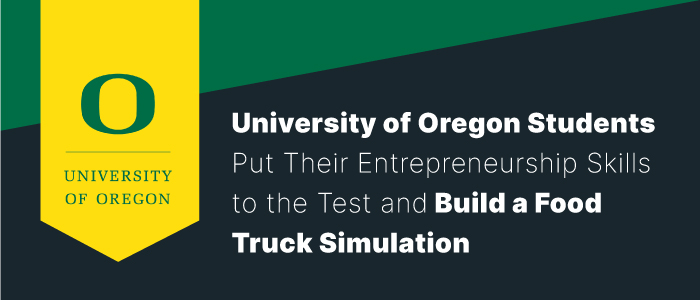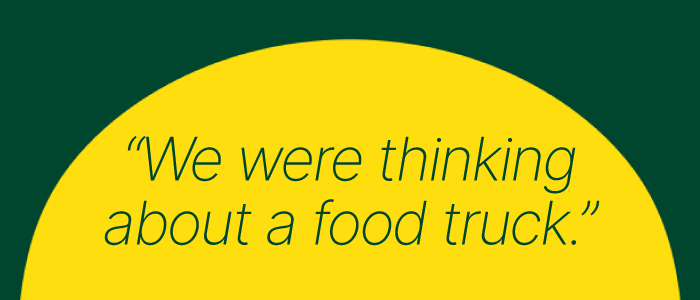University of Oregon Students Put Their Entrepreneurship Skills to the Test and Build a Food Truck Simulation
July 30, 2021

What seemed like an out-of-the-ordinary concept for a simulation managed to land safely in the CapsimInbox Authoring Platform.
Since its inception, we’ve seen many creative and innovative applications for CapsimInbox.
Still, at first glance, it wasn’t crystal clear to see how a team of four University of Oregon Ducks--Brian Dougherty, Connor Waterloo, Sawyer Medlin, and Eli Serrao--could bring the experience of managing a food truck to life, a concept that typically takes place in-person with customer interaction and actual face time.
Over eight weeks, the team of students brought their idea to fruition.
How Four Undergraduate Students Built an Immersive Entrepreneurship Simulation
How far can you stretch an inbox simulation?
Even if a concept seems unconventional, we bet you can build it into an inbox simulation.
Simulation building is typically a collaborative process that benefits from multiple inputs and expertise. No idea is too big to put into the context of an engaging and immersive simulation experience.
We found this out first-hand as four college undergraduate students recreated life as a food truck owner and operator.
Driving an Entrepreneurship Simulation Forward with Food Truck Management
Dr. Ralph Heidl’s MGMT 455 Implementing Entrepreneurial Strategies Capstone course develops the skills needed to create, launch, and grow innovative new ventures – either as startups or within established businesses.
The team faced a few options. Among them, to work with a handful of companies to evaluate their performance, conduct research, and provide recommendations for improvement.
“Most of the other companies were looking for the students to conduct market research,” Eli Serrao said, “while Capsim wanted us to make an entire simulation which seemed more interactive and engaging.”
Initially, the team of Oregon Ducks didn’t foresee a revenue-generating opportunity from a classroom assignment. But the CapsimInbox Authoring Platform offers all builders the chance to profit from their work.
“We were thinking about a food truck,” the University of Oregon team of four students shared. The Capsim team looked at each other through the Zoom camera in silence. A simulation centered around something that typically takes place in-person with customer interaction and real face time?
“Why don’t you bring your ideas to our next meeting?” We left it open-ended. If the team had ideas they could back up and support; we would find a way to make it happen. It wasn’t long before we started weekly check-ins with the team.
A Research-based Method to Madness
The team took time to conduct multiple rounds of in-depth research before building and creating the demo experience. In the first round of research, the squad conducted four in-depth interviews with MGMT 355 students to garner their insight and opinions on simulations and the undergraduate class as a whole.
In addition to student interviews, the group met with Dr. Heidl, Associate Professor of Management at University of Oregon; Kate Harmon, Director of Cross-Campus Engagement and Instructor of Management at Lundquist Center for Entrepreneurship; and Alex Murray, Assistant Professor of Management 355: Launching New Ventures. They gathered the faculty’s thoughts on what content would be the most valuable to include in an immersive simulation that could be leveraged in existing courses at their university.
What began as an unconventional idea quickly turned gears and resonated with University of Oregon staff and students. After initial research to gather more qualitative information on preferences and topics for their simulation, the team tinkered away.
Soon, the team was on its way to create a simulation focused on initial financial decisions for a startup company. Specifically, the user starts a food truck restaurant, where they will have to make decisions about location, loan offers, and purchasing an actual food truck.
Financing, Negotiation, Cash vs. King, and weighing standard loan offers from US Bank, Wells Fargo, and even an equity deal proposed by Uncle George.
Food trucks, as it turns out, are the perfect entry point into the food industry. They provide entrepreneurs with the opportunity to hone in on the location, product, menu, and food. In addition, food truck owners can gain a loyal following and build up raving fans with word of mouth. Eventually, you’ve already built up a dedicated customer base if you decide to venture into the restaurant industry.
The team met multiple times weekly to bring their ideas and characters to life. “The most memorable part of the building experience was the creativity that we used on the storyline and characters we had in our simulation,” Eli said.
.png?width=700&name=MicrosoftTeams-image%20(15).png)
The Best is Yet to Come: the Simulation goes on
After presenting their analysis, the team shared thoughts on future implementation. It turns out this brief simulation is just the beginning of what could become a fully comprehensive entrepreneurship version for other programs.
What the team initially envisioned as a simple food truck simulation can eventually incorporate supply chains, more extensive menu options, targeting specific food connoisseurs, expanding suppliers, and leading to a more high-end luxury food cart. After building comprehensive marketing strategies by hiring an external marketing agency or conducting guerilla social media strategies, the business would--hopefully--boom.
Once the users experienced the savory taste of success, they envisioned the final portion of the simulation as a buyout section. The scenario would take place five to ten years after the initial investment as the food truck flourishes. After feeling burnt out from working in a food truck for nearly a decade, new opportunities arise. The participant now faces enticing offers from prominent investors. It’s the owner’s responsibility to strategically consider all offers and embark on one final negotiation run.
Professor Murray, hesitant to consider simulations in the first place, and someone who previously considered them "busy work," saw the value in simulations that could tie in relevant and applicable material while simultaneously focusing on real-world issues.
After sending out their demo and a survey to their classmates, professors, and a few Capsim employees, the team was met with positive feedback, and some room for improvement. They added in the initial purchase of a food truck to put critical thinking and negotiation skills to the test.
The team had a great building experience and wants to continue building the next few chapters of their immersive story to tie in more relevant concepts from University of Oregon's entrepreneurship courses.
Create Your Own Engaging Learning Experiences Now
If a group of four undergraduate students can build a comprehensive entrepreneurship simulation, what’s holding you back? Start building today in the CapsimInbox Authoring Platform.
Looking for an off-the-shelf solution? Check out Capsim’s microsimulation offerings to bring real-life experiences to your students today.
Discover More Real-word Use Cases
Explore how instructors are bringing diverse course content to life >>





.png?width=80&name=1-questions%20(1).png)